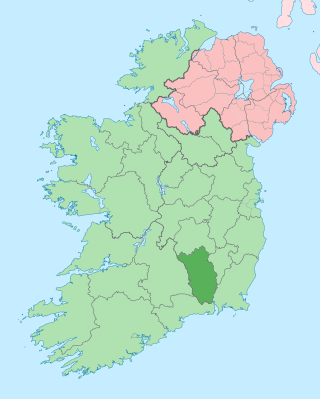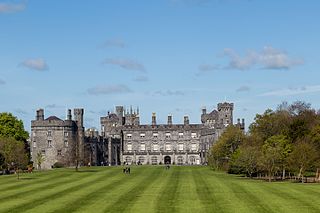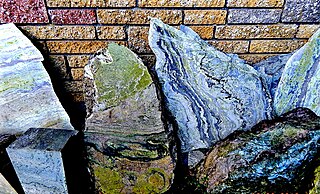
County Kilkenny is a county in Ireland. It is in the province of Leinster and is part of the Southern Region. It is named after the city of Kilkenny. Kilkenny County Council is the local authority for the county. At the 2022 census the population of the county was 103,685. The county was based on the historic Gaelic kingdom of Ossory (Osraighe), which was coterminous with the Diocese of Ossory.

Kilkenny is a city in County Kilkenny, Ireland. It is located in the South-East Region and in the province of Leinster. It is built on both banks of the River Nore. The 2022 census gave the population of Kilkenny as 27,184, the thirteenth-largest urban center in Ireland.

County Carlow is a county located in the Southern Region of Ireland, within the province of Leinster. Carlow is the second smallest and the third least populous of Ireland's 32 traditional counties. Carlow County Council is the governing local authority.

Portland stone is a limestone geological formation dating to the Tithonian age of the Late Jurassic that is quarried on the Isle of Portland in Dorset, England. The quarries are cut in beds of white-grey limestone separated by chert beds. It has been used extensively as a building stone throughout the British Isles, notably in major public buildings in London such as St Paul's Cathedral and Buckingham Palace. Portland stone is also exported to many countries, being used for example at the United Nations headquarters in New York City.

Abraham Colles was Professor of Anatomy, Surgery and Physiology at the Royal College of Surgeons in Ireland (RCSI) and the President of RCSI in 1802 and 1830. A prestigious Colles Medal & Travelling Fellowship in Surgery is awarded competitively annually to an Irish surgical trainee embarking on higher specialist training abroad before returning to establish practice in Ireland.

Yule Marble is a marble of metamorphosed Leadville Limestone found only in the Yule Creek Valley, in the West Elk Mountains of Colorado, 2.8 miles (4.5 km) southeast of the town of Marble, Colorado. First discovered in 1873, it is quarried underground at an elevation of 9,300 feet (2,800 m) above sea level—in contrast to most marble, which is quarried from an open pit and at much lower elevations.

Castlecomer is a town in the north of County Kilkenny, Ireland. It is positioned at the meeting of N78 and R694 roads about 16 km (9.9 mi) north of Kilkenny city. At the 2016 census, Castlecomer had a population of 1,502 people. The town is in a townland and civil parish of the same name.
Purbeck Marble is a fossiliferous limestone found in the Isle of Purbeck, a peninsula in south-east Dorset, England. It is a variety of Purbeck stone that has been quarried since at least Roman times as a decorative building stone.

Carboniferous Limestone is a collective term for the succession of limestones occurring widely throughout Great Britain and Ireland that were deposited during the Dinantian Epoch of the Carboniferous Period. These rocks formed between 363 and 325 million years ago. Within England and Wales, the entire limestone succession, which includes subordinate mudstones and some thin sandstones, is known as the Carboniferous Limestone Supergroup.

Gurney Slade quarry, grid reference ST626497 is a limestone quarry near Gurney Slade between Binegar and Holcombe, on the Mendip Hills, Somerset, England.

Tennessee marble is a type of crystalline limestone found only in East Tennessee, in the southeastern United States. Long esteemed by architects and builders for its pinkish-gray color and the ease with which it is polished, the stone has been used in the construction of numerous notable buildings and monuments throughout the United States and Canada, including the National Gallery of Art, National Air and Space Museum, and United States Capitol in Washington, D.C., the Minnesota State Capitol, Grand Central Terminal in New York, and Union Station in Toronto. Tennessee marble achieved such popularity in the late-19th century that Knoxville, the stone's primary finishing and distribution center, became known as "The Marble City."

The Cathedral of the Assumption is both the cathedral church of the Roman Catholic Diocese of Kildare and Leighlin and the parish church for the cathedral parish. Located in Carlow town, the cathedral was dedicated to the Assumption of the Blessed Virgin Mary in 1833. It is known for its beautifully detailed 151 ft (46 m) spire which is one of the highest points in the town.
The geology of Merseyside in northwest England largely consists of a faulted sequence of Carboniferous Coal Measures rocks overlain in the west by younger Triassic and Permian age sandstones and mudstones. Glaciation during the present Quaternary Period has left widespread glacial till as well as erosional landforms. Other post-glacial superficial deposits such as river and estuarine alluvium, peat and blown sand are abundant.
The geology of County Durham in northeast England consists of a basement of Lower Palaeozoic rocks overlain by a varying thickness of Carboniferous and Permo-Triassic sedimentary rocks which dip generally eastwards towards the North Sea. These have been intruded by a pluton, sills and dykes at various times from the Devonian Period to the Palaeogene. The whole is overlain by a suite of unconsolidated deposits of Quaternary age arising from glaciation and from other processes operating during the post-glacial period to the present. The geological interest of the west of the county was recognised by the designation in 2003 of the North Pennines Area of Outstanding Natural Beauty as a European Geopark.

A ledger stone or ledgerstone is an inscribed stone slab usually laid into the floor of a church to commemorate or mark the place of the burial of an important deceased person. The term "ledger" derives from the Middle English words lygger, ligger or leger, themselves derived from the root of the Old English verb liċġan, meaning to lie (down). Ledger stones may also be found as slabs forming the tops of tomb chest monuments.

Green's Bridge, or Greensbridge, is an elegant, Palladian-style, limestone arch bridge that crosses the river Nore in Kilkenny, Ireland. The bridge is a series of five elliptical arches of high-quality carved limestone masonry with a two-arch culvert to the east. Its graceful profile, architectural design value, and civil engineering heritage endow it with national significance. Historian Maurice Craig described it as one of the five-finest bridges in Ireland. It was built by William Colles and designed by George Smith, and was completed in 1766. The bridge was 250 years old in 2016.
The geology of the Isle of Man consists primarily of a thick pile of sedimentary rocks dating from the Ordovician period, together with smaller areas of later sedimentary and extrusive igneous strata. The older strata was folded and faulted during the Caledonian and Acadian orogenies The bedrock is overlain by a range of glacial and post-glacial deposits. Igneous intrusions in the form of dykes and plutons are common, some associated with mineralisation which spawned a minor metal mining industry.

Connemara marble or "Irish green" is a rare variety of green marble from Connemara, Ireland. It is used as a decoration and building material. Its colour causes it to often be associated with the Irish identity, and for this reason it has been named the national gemstone of Ireland. It strongly resembles the verd antique, a green serpentinite breccia found in the Mediterranean. It is named after the region in which it is found. The marble was deposited as a limestone mud during the neoproterozoic.

Frosterley Marble is a black, bituminous coraliferous limestone containing fossil crinoids of the Lower Carboniferous, some 325 million years ago. It outcrops in Weardale, County Durham, England, including near the village of Frosterley whence it is named.















